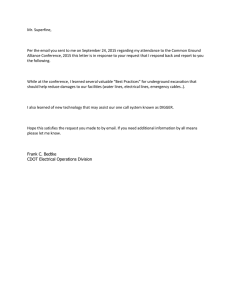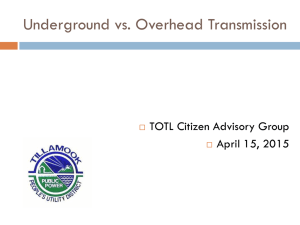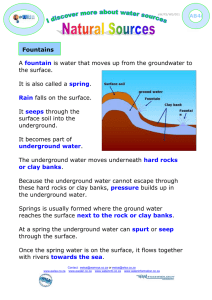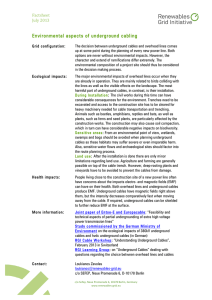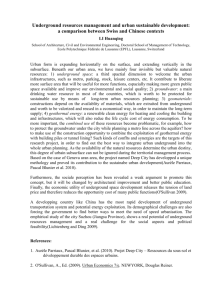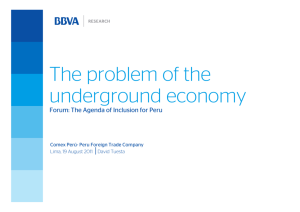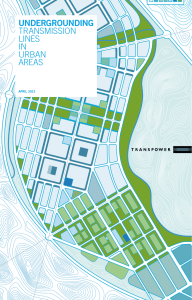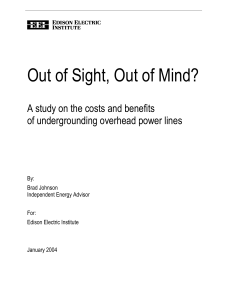trends in the `undergrounding` of power lines
advertisement
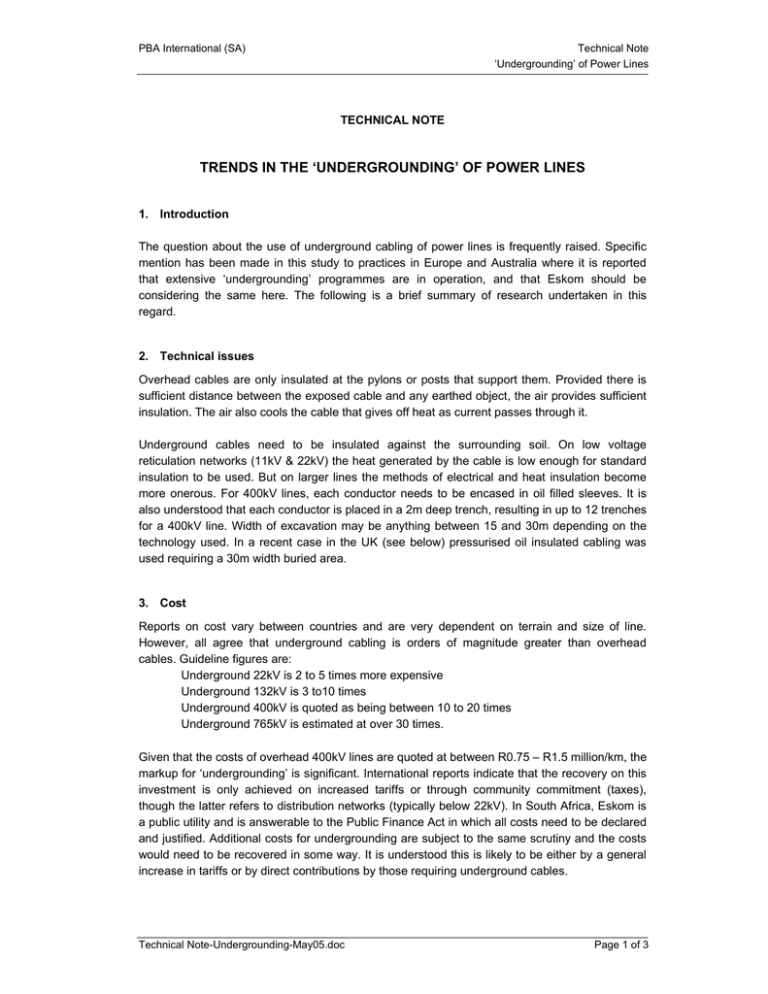
PBA International (SA) Technical Note ‘Undergrounding’ of Power Lines TECHNICAL NOTE TRENDS IN THE ‘UNDERGROUNDING’ OF POWER LINES 1. Introduction The question about the use of underground cabling of power lines is frequently raised. Specific mention has been made in this study to practices in Europe and Australia where it is reported that extensive ‘undergrounding’ programmes are in operation, and that Eskom should be considering the same here. The following is a brief summary of research undertaken in this regard. 2. Technical issues Overhead cables are only insulated at the pylons or posts that support them. Provided there is sufficient distance between the exposed cable and any earthed object, the air provides sufficient insulation. The air also cools the cable that gives off heat as current passes through it. Underground cables need to be insulated against the surrounding soil. On low voltage reticulation networks (11kV & 22kV) the heat generated by the cable is low enough for standard insulation to be used. But on larger lines the methods of electrical and heat insulation become more onerous. For 400kV lines, each conductor needs to be encased in oil filled sleeves. It is also understood that each conductor is placed in a 2m deep trench, resulting in up to 12 trenches for a 400kV line. Width of excavation may be anything between 15 and 30m depending on the technology used. In a recent case in the UK (see below) pressurised oil insulated cabling was used requiring a 30m width buried area. 3. Cost Reports on cost vary between countries and are very dependent on terrain and size of line. However, all agree that underground cabling is orders of magnitude greater than overhead cables. Guideline figures are: Underground 22kV is 2 to 5 times more expensive Underground 132kV is 3 to10 times Underground 400kV is quoted as being between 10 to 20 times Underground 765kV is estimated at over 30 times. Given that the costs of overhead 400kV lines are quoted at between R0.75 – R1.5 million/km, the markup for ‘undergrounding’ is significant. International reports indicate that the recovery on this investment is only achieved on increased tariffs or through community commitment (taxes), though the latter refers to distribution networks (typically below 22kV). In South Africa, Eskom is a public utility and is answerable to the Public Finance Act in which all costs need to be declared and justified. Additional costs for undergrounding are subject to the same scrutiny and the costs would need to be recovered in some way. It is understood this is likely to be either by a general increase in tariffs or by direct contributions by those requiring underground cables. Technical Note-Undergrounding-May05.doc Page 1 of 3 PBA International (SA) Technical Note ‘Undergrounding’ of Power Lines 4. Maintenance A mixed result arises here. Underground cables are reported to be more reliable, but outages are more difficult to fix as it is harder to find the fault, and therefore the outages last much longer on underground cables3. Also, routine maintenance of underground cables is much lower in the initial years of operation (first 10 years appears to be the time span most regularly referred to), but maintenance costs can rise steeply thereafter. The lifespan of underground cabling is also shorter, in some cases it is reported to be half that of overhead cables. Nevertheless, there seems to be general agreement that the maintenance and operation of underground cabling is cheaper than overhead cabling. It has been reported that in the UK overhead line maintenance is estimated at £600/circuit-km/year (approx. R6600) while underground cable maintenance is at around £70/circuit-km/year (approx. R770). 5. Visual benefits of ‘undergrounding’ It is commonly stated that there are distinct visual impact benefits in using underground cables. In the main this is seen to be true, especially in the urban environment where the observer is closer to the line and the land cover is largely disturbed from its natural state. However, in the natural environment, especially wooded and thornveld areas, root management may require that trees are kept out of the servitude and a 15-30m wide strip is cleared. Such strips in woodland areas are normally more noticeable at a distance than a power line (servitude management guidelines for overhead lines now allow small trees to remain under 400kV lines). Hence, it is not automatic that visual impacts are avoided by using underground cables. This would need to be assessed in each case. 6. Trends in ‘undergrounding’ Underground electricity cables are typically only used in developed countries such as in the US, Europe and Australia. Some of these have adopted policies on undergrounding (eg Netherlands and France, and some states in Australia), but these focus on low and medium voltage networks (200V to 50kV). The Netherlands, for example, adopted an underground cabling policy in the 1970’s and has 100% of its low to medium voltage network underground. Next best is Belgium and the UK at 85% and 81% respectively. The average for Europe is estimated at around 50% to 60%1. The picture for high (60kV to 150kV) to extra high voltages (220kV and above) is quite different. Some countries have achieved in undergrounding between 10% and 20% of their high voltage cables, while other European countries are less than 10%. For extra high voltage the average is around 2%, with only 0.5% of the 400kV network underground. In the high and extra high voltage categories the underground sections are special projects in urban or highly sensitive environmental areas. In the US some 50% of capital expenditure on power lines is for underground lines, though still 80% of the infrastructure is overhead2. 1 Commission of European Community, December 2003. Background Paper: Undergrounding of Electricity Lines in Europe. 2 Brad Johnson, January 2004. Out of Sight, Out of Mind? A study of the costs and benefits of undergrounding overhead power lines. Edison Electric Institute. Technical Note-Undergrounding-May05.doc Page 2 of 3 PBA International (SA) Technical Note ‘Undergrounding’ of Power Lines Hence, in developed countries there is a growth in underground cabling of low voltage distribution systems, the undergrounding of high voltage lines is rare and limited to highly sensitive areas. However, while there appears to be no policy development towards undergrounding high voltage lines, it is fair to report that the EU has given more attention to this in recent years as the interconnection between countries to reinforce national networks is being met with growing opposition. There is little information on underground electricity cables in developing countries. Though it is known that it does occur in some city areas, it is expected the practice of undergrounding is well behind that of developed nations. In South Africa, new 11kV lines in residential areas are more regularly buried. However, though undergrounding of higher voltage lines has been considered at sensitive sites, it is understood that none have been constructed. Underground cables are not being considered as an alternative on the Braamhoek Transmission integration project. Cost will be a primary concern, but given the existence of 400kV and other lines in the study area, the potential environmental sensitivity of the area is seen to be considerably reduced. 7. Case example: Middlesbrough-York 400kV line (UK)3. The Middlesbrough-York Line (United Kingdom) The 70 km long overhead line with two 400 kV circuits (each with a capacity of 2,000 MW) connects the cities of Middlesbrough and York. Significant public concern was raised over the decision to put overhead lines, rather than cables, through the Vale of York. An application to construct the line was made in 1991. Following several years of public enquiries and hearings it took 10 years for all consents and wayleaves to be put in place. National Grid was not in favour of an underground cable on the grounds of cost (the overhead line was expected to cost £540,000/km (approx R6m/km) and the cable £8.9 million/km (approx. R98m/km), a cost factor multiple of 16 times) and environmental concerns over a 15-30 metre swathe of sterilised land through the countryside. The UK government took the view that the additional cost could not be justified and the aerial route was eventually given the go-ahead with the exception of a 5.7 km cable section in the middle of the English countryside. The technology used is a pressurized oil-insulated cable. The buried part covers a total ground area of 30 m of width and cost about 100 million (Euro) (Approx R130million/km). Please note, these are UK costs and are affected by local technical costs (eg terrain difficulties) and differences in the economies between two countries. However, this provides a good example of the scale of costs and decisions that have been made elsewhere in the world. Last update: May 2005 3 REVOLT News, November 2004. Issue 174. Technical Note-Undergrounding-May05.doc Page 3 of 3
